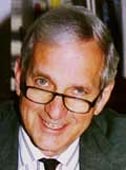Surgical Education Should Begin Early

Martin McKneally
|
Our undergraduate surgery program is spotlighted in
this issue of the newsletter. The expansion of the exposure
of our surgical faculty to the preclerkship level is
a welcome development, based on the accounts from
our undergraduate students Nada Gawad and Michael
Bond. When students are exposed to surgical tasks like
suturing and coached by surgical role models, the drapes
that separated them from the arcane and mysterious
world of surgery are lowered.
Our students are deciding early about their future
careers and they need early active learning in surgery to try
on the technology, culture and values of the surgical profession.
“I could imagine myself doing that, especially with
some experience” requires seeing, experiencing and doing
some of the fascinating work of surgery with the right
role models and mentors. George Christakis and Shibu
Thomas are providing just exactly that and doing it well.
The suturing sessions with preclerkship students in the
first and second years have exposed undergraduates to John
Wedge, Jim Rutka and a superb cast of faculty surgeons
who are accessible and interested in helping them develop
their understanding and test their aptitude for surgery.
Delaying surgery until clerkship misses the opportunity
to inspire, converse and present role models sufficiently
early in medical school. I was inspired by the
diagnostic skills of thoracic surgeons William Barnes and
Eugene Cliffton at New York Hospital and Memorial
Sloan Kettering when I was an undergraduate. My
mentor Hollan Farr showed me surgical humanity and
patience, when I called him unnecessarily at midnight. I
was worried about crepitus in the laparotomy wound of
the dog my classmates and I had operated upon with him
in the laboratory that afternoon. “It’s just air trapped in
the tissue planes. It’s too early for gas gangrene, but I’m
glad you called to check it out.”
|
Surgical Skills and knowing surgeons enable future family
doctors to provide basic surgical care in the emergency room
and assist at operations in their later practice. Surgeons of
the future who are drawn to train for the specialty now will
need more facilities to enable importing patients who are
attracted, and able to pay to support and expand Canada’s
excellent public system. They will likely disperse after their
formal training to distant parts of Canada and the rest of
the world as part of their career development, adding richly
to their experience. They will help the specialty evolve, as
the recent exciting work with organ repair for transplantation,
the development of bariatric surgery, and multi-modal
stenting for vascular and cardiac disease will change surgery
as we currently know it. They will also develop economical
solutions to bend the cost curve down to more realistic
levels. (see also: http://www.surgicalspotlight.ca/Article.asp x?ver=Fall_2011&f=BusinessNeurosurgery). Our training
programs will be refined to a needs based economic model
as disruptive innovations displace or modify the more elaborate,
traditional technology of many contemporary operations,
the way stenting, minimal access techniques, and off
pump variants have modified vascular and cardiac surgery.
Bravo to George Christakis, Shibu Thomas, our students
and our surgical educators for the excellent initiatives
in undergraduate education described in this issue.
Correction:
The Editor’s Column in the Fall issue contained a misprint.
The correct statement should read: This innovative direct entry
program in Cardiac Surgery was established in Canada in 1994.
|